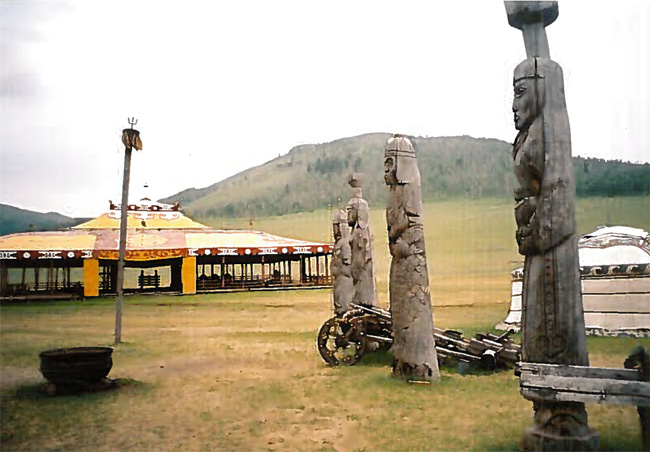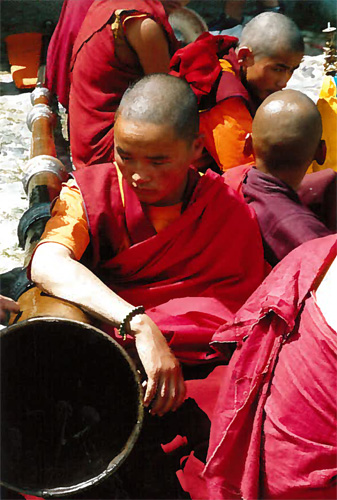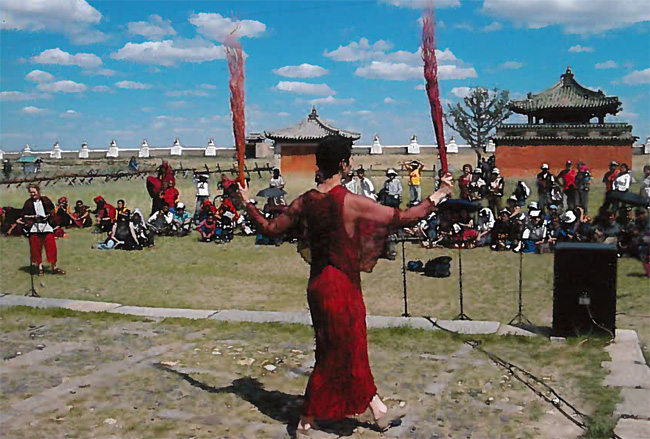From the Fire to the Eagle
Nancy Zendora
November 2016
 photo courtesy of Marie Baker-Lee
photo courtesy of Marie Baker-Lee
From the Fire to the Eagle: A Bird’s Algebra in Desert Time
Outer Mongolia, summer, earth and air – stars sparkle in the night sky. We were a caravan of 100 performers: musicians, dancers, performance artists and 100 guests; journalists, doctors, music lovers, visual artists — Mongolians, Europeans, Asians, Americans, all age 20 to 80, traveling together through the desert to encounter the life of traditional people in dialogue with the contemporary west. A police escort plus four jeeps and six buses made their way through the mini Gobi for performances in monasteries, desert environments, mountain temples, late night Ger concerts: concerts of contemporary music, dance, performance art and traditional throat singing, as well as instrumentalists from the obscure corners of Mongolia.
Dancer Marie Baker-Lee and I, were invited by the New Music Association of Mongolia and Bernhard Wulff, a German composer/musician, the two organizers of the Roaring Hooves Festival. We fly via China. On our plane is Chaolum Bataar, an installation artist from Inner Mongolia (part of China), who lives in New York and whose works include fire and nature. Upon our arrival, we were taken to our Ger Camp, a group of octagonal and hexagonal wooden, cross-hatched structures similar to a Yurta, and lined with sheep fur. A hole in the center provided the source for air. This would be our home for the next seven days. each brisk morning and evening, a fire was made for us to warm our sleeping and waking moments. We lived the lifestyle of the nomads we were with, surrounded by animals whose cries were our first morning greetings.
Our four performances in diverse environments presented unusual challenges for us. For our presentations I chose three sections from “A Bird’s Algebra in Desert Time,” two solos and a duet inspired by my travels to the deserts of Syria, Egypt and Mexico. We performed these works separately, on different programs.
I performed “The Voice of Light” in the capital city Ulaanbaatar, in a monastery that had been converted into a museum. Our dressing room was the monastery itself, the “stage” a small, contained, porch like entrance area. The audience of several hundred tourists and local people sat on chairs on the grassy entrance, attentive and relaxed, and moved around the grounds, focusing at different moments in different ways.
We performers warmed up our bodies and our instruments, contemplating the tankas, the painted ceiling and the sculpture in the 11th century temple. I entered the performance space wearing a white, billowy, pleated dress, carrying a pyramid light. I could feel the waiting presence of the other performers behind me in a shadowy darkness. A circle of intensity was formed with the audience in front and on two sides demanding that I have eyes in all directions. Upon my entrance, four photographers were snapping madly close by. For a moment I felt like a Kabuki performer, making my “mie” (a quick sharp pose thought to acknowledge the audience) as I summoned my powers of concentration. The night was cold, my dress light. I began with a bird’s voice crying to the evening air. I felt the tension between fragility and strength in the image of the bird, which symbolized in movement the struggle of the human spirit to fly.
Early the next day our caravan moved to our desert Ger camp. That evening we attended a Shaman ceremony with fire, as the sky loomed above us in a clarity that seemed surreal– but hardly less so than the next day’s performances in the desert, where electronic equipment, cellos, trap drums, woodwinds and piano graced the incongruous landscape. Marie began “Until…” from the edge of the sight lines, as onlookers sat on a hill facing a large embankment. From the distance, her turquoise-robed figure sharpened into focus and prepared us for her entrance. The audience of seated performers and nomads on horseback were transfixed as she adjusted the movement to gain traction by kicking up the sand. That afternoon there was wildness in Marie as she understood that this work, meant for the stage but performed in a desert, demanded a new power and intensity to focus the audience. As she exited, the desert wind followed her diminishing figure; her wind-blown dress was like tiny, colored sails disappearing to the edge of sight.
Some of the many performances were site specific. Visions of a black-clad singer rushing down the sandbacks, or a dancer in white moving on a hilly crest in front of a cloud, were pure magic. Traditional Mongolian musicians, in colorful ancient clothing, also performed, igniting the desert monochrome with excitement in sound and sight. Although many stayed for the four-hour afternoon concert, there were questions about the value of these events. Could the denizens of the desert understand them? Was it appropriate to bring John Cage, Steve Reich and post-modern performance to people who had never heard Mozart or seen Martha Graham. Does any of that matter?!
 photo courtesy of Marie Baker-Lee
photo courtesy of Marie Baker-Lee
That morning and the next day, in a mini Nasdam Festival near our Ger camp, we had a chance to see some Mongolian traditional festival activities: horse racing; small ponies raced by young children; as well as young men in shorts and fitted tops wrestling like eagles (the loser opened his belt as the winner imitated the gestures of a flying eagle). The gathering of people of all ages, for what seemed to us so little excitement, made me think that we urbanities had lost the simple camaraderie that allowed them to connect with their neighbors across the vast landscape.
In Karkorum, the old capital of Mongolia, we visited a monastery that had almost been destroyed by the Russians. (Most signs in Mongolia are still in Cyrillic. While the Russians were there, Mongolians were not allowed to speak or learn their own language at school.) The monastery was a walled compound containing several temples and courtyards. At the entrance to tone of the compounds sat Mongolian Monk Musicians dressed in crimson and deep red purples with accents of gold. They greeted us by playing long horns. A stone entrance of about 500 square feel was our performance area. We changed and warmed up in the inner courtyard, which had access to smaller sanctuaries whose entrances encircled the area. In our waiting moments we observed the sacred mysteries of tankas and Tibetan scriptures. We were performers, acrobats, masked folk-dancers, traditional musicians of horsehair fiddle and throat singers, as well as Western musicians, percussionists, singers of contemporary music, and an assortment of improvisers, dancers and performance artists. In this sacred and magical play, Marie and I performed “The Descent,” a duet based on the Sumerian Fertility Myth of the Goddess Inanna’s descent into the underworld to console her dark sister Erishkegal. In the myth, Inanna is tormented, turned in a piece of meat and, in a ruse, taken back to the above-world by a trusted servant. Marie is the Inanna figure and I am both the dark sister and the trusted servant, the many archetypal shadow figures in the field of consciousness. The sister/shadow relationship between us is strong in unisons, repetitions and mirroring movements as we carry crimson and rose colored branches. We are coincidentally dressed in the same colors as the Monks, and blend into the atmosphere. It was difficult to perform on round stone fragments imbedded in small patches of grass. We had to adjust our movements, slowing or speeding them to negotiate the more difficult footings. Performing outdoors without any container for either audience or performers was an experience in intense concentration. We warmed up on stone, performed on stone and left our belongings on stone. Afterwards, meandering through the grounds, when my feet touched the grass I felt like a thirsty person who has suddenly drunk.
 photo courtesy of Marie Baker-Lee
photo courtesy of Marie Baker-Lee
We drove by bus for three hours into the mountains, to a place reminiscent of the American southwest, with strange rock formations and sacred areas built and nestled into rock. This was the site for performances of singers, shamans and improvisers. I was entranced by the Khoomi singers, who could project so many tones, hardly openings their mouths; and the dumba (small ouds) player, Papizan, who could play two instruments at once at breakneck speeds. Marie and I were part of a group of walkers and listeners. Ruins and contemplative pathways led us into the mountain retreats. We received gifts and brought traditional Mongolian-fashioned hats. That evening were more Ger concerts of quieter music, and solo singing by Kurt Widmer, a Swiss baritone who performed a piece by Kunio Imai from Japan — an interesting collaboration that had formed before the festival began. There were also guest visual artists. A German painter, Karin Fleischer, was exploring painting to music. Her work looked like calligraphy for a music staff. Karin, Kunio and I had resonant sensibilities: quiet, reflective work where meaning is created by stillness, emptiness and silence. Our shared moments provided times to explore new possibilities for collaborations.
In the evenings, looking at the landscape and hearing the horses, birds, yaks and other animals, one could also hear new sounds coming from some of the Gers: Mongolian singers with German percussionists, dumba players with woodwinds, English folk musicians with traditional Khoomi singers, signifying new friendships and cultural syntheses in the making. Questions arose about the language inherent in any art form, and thoughts about how one can find differences more stimulating than disturbing. I began to love the discussions that permeated our eating and leisure moments amidst such a range of cultures, artists and intellectuals. In my master classes, the students were a combination of movers, actors, journalists and ordinary Mongolians. The asked: “Are your works ancient or contemporary? Do you have a set vocabulary like jazz classes or ballroom dancing or ballet? How do you work on a piece?” Our dialogue began with their traditions rooted in myth and ritual. I could see they were excited by my interest in improvisation, finding new movement language for each work. Their climate and lifestyle demanded tremendous energy and stamina which was reflected in their love of movement and receptivity of new ideas.
When we sing and dance together, play music and make art, we find new communication that energizes and excited the positive possibilities of humanity. Can we balance this with the reality of endless wars that scourge our planet? We were all grateful (artists and guests) for the opportunity of the festival and we wish to inhabit that place of openness and clarity like the beauty of the desert night sky.
 photo courtesy of Marie Baker-Lee
photo courtesy of Marie Baker-Lee

This article is beautifully and descriptively written. I cannot think of any other meeting where such diverse cultures with their art and/or interest come together in such locations.
Wouldn’t it be nice if stories like these filled the evening news. Thank you — and arteidolia– for sharing it.